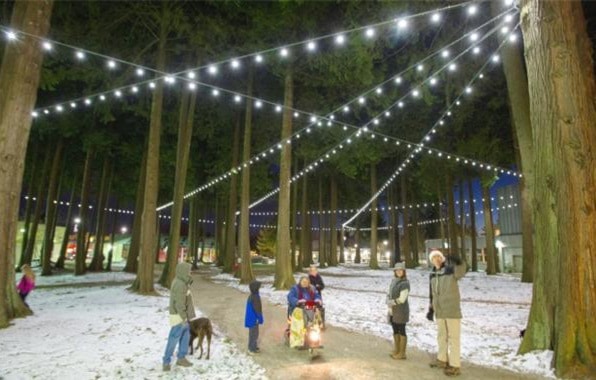SURREY — Residents of Surrey were outraged last December when 53-year-old Julie Paskall died following a savage assault in a recreation centre parking lot.
The attack prompted calls for more police officers and stiffer sentences, but also drew attention to a need for better lighting in some parts of the city.
With lighting, however, sometimes less is more, according to experts on crime prevention and design.
Colleen Kerr, crime reduction strategy manager for the City of Surrey, said the city’s newly-adopted official community plan has added policies to protect its residents which follow the principles of CPTED: crime prevention through environmental design.
CPTED fights crime using community engagement, surveillance, property maintenance, physical barriers and other environmental tweaking –- including the strategic use of lighting.
“If not applied appropriately, under many circumstances lighting levels may actually increase crime,†Kerr wrote in an email.
“Adding lighting may only serve to draw people to the area.â€
Greg Perkins, owner of Liahona Security and a CPTED consultant in B.C., has taught CPTED to RCMP, urban planners and municipalities throughout B.C.
He said a critical aspect of using lighting to prevent crime is ensuring that it’s evenly distributed.
“Using less light — if it’s evenly applied to the horizontal plane and has good vertical illumination — then retailers and municipalities can spend less money, use less energy and still create safe visual environments for people.â€
Perkins said uneven lighting can create hiding spaces for offenders while putting a spotlight on victims.
“If a walkway is not a safe route and you’ve illuminated it, quite often we have assaults that occur along them because the offenders hide in darkness, just off the trail, and now they can see people come and go. They can pick their targets as they will.â€
The illumination of space is very site-specific, Perkins said, but often simply turning off the lights in problem areas can serve to stop nuisance behaviour and crime.
“Most parks have bylaws that say from dusk to dawn, you can’t be in the park. So why would we illuminate a part of the park that only draws unwelcome users into that area?â€
CPTED was a consideration for a Surrey community group called The Friends of The Grove, which last month organized a light-hanging ceremony in the wooded area close to where Paskall was attacked.
Group organizer David Dalley said he’s seen a lot more foot traffic through the area since the City of Surrey paid for and installed strings of timer-operated lights.
“It’s been a huge change. It just makes people more comfortable in the area, it brings more people into the area.â€
Paskall’s death also inspired Grant Mansiere, a grade 9 Summerland Middle School Student student, to find out how lighting affects crime, after he heard people in the media criticizing the lighting in the parking lot where Paskall was attacked.
Mansiere received awards and scholarships for using RCMP crime data, NASA satellite data and his own research to come to some surprising conclusions while working on the project in his hometown.
“Where there’s high levels of light, there’s high levels of crime,†Mansiere said. “That correlation showed in both Pentincton and Summerland, and it was a strong correlation.â€
Mansiere recommended property owners use LED lightbulbs installed into efficient fixtures that aim at the ground, and opt for lower-wattage bulbs when replacing them, in order to reduce levels of light pollution that may encourage crime.
Lighting also became a pressing concern at the University of B.C. campus last year following a string of late-night sexual assaults that prompted the university to develop a plan to address campus safety.
Doug Doyle, associate director of infrastructure planning at UBC, said he was part of a walking tour that identified landscaping as a key issue — there were concerns about places where an assailant could hide — but which also found gaps in the lighting on some major walking routes, often caused by the rapid pace of development on campus.
UBC has been installing more lighting and upgrading existing fixtures to ensure better, more consistent lighting on these routes, Doyle said.
CPTED also serves a purpose in retail, such as in Mac’s Convenience Stores, which follow the “best practices of CPTED,†according to Doug Hartle, spokesman for Mac’s Convenience Stores in Western Canada.
Hartle said the company’s practice at the 311 locations in his region is to not limit the lighting.
Tony Hunt, loss prevention general manager for London Drugs, said the retailer uses CPTED practices to ensure its stores are well-illuminated inside but also evenly lit outside, so shoppers don’t feel threatened by what lurks in the dark when exiting the stores.
In recent years, businesses in the United Kingdom have been experimenting with installing ‘acne lighting’, bright pink lights that highlight teens’ acne, discouraging them from loitering.
For more stories by the Province, click here.
